Inside Guide to Thai Cuisine and The Regional Variety
Thailand is a foodie paradise par excellence, without a doubt. The sanctified temples, royal palaces, golden Buddhas, elephant sanctuaries, white-sand beaches and adventure rides will be brief romances before the main event – eating!
Overview
Thailand stands at the crossroads of ancient cultural traditions dominated by India, China and Asian Oceania. It has adapted cooking techniques and ingredients from all three of these major provinces of influence.
Thai food is known for its enthusiastic use of fresh (rather than dried) herbs and spices, striking a balance of four flavours: sweet, salty, sour, and spicy. The essence of authentic Thai flavours; sweet is through sugar or palm sugar, salty flavour is provided by dried shrimp, fish sauce, or shrimp paste; sour, by vinegar, tamarind, and limes, and spiciness by a range of herbs, peppercorns, and chiles.

Lightly prepared dishes, strong aromatic components, flavours with a spicy edge and ingredients with flavour and medicinal properties make Thai food a widely popular cuisine. Although Thai cuisine, as we know it, encompasses culinary diversity that includes dishes from all of these subsidiary regional culinary cuisines. Each region has its own cooking style and characteristic taste according to available ingredients. Most importantly, it also features ingredients deriving from the regional soil.
For deeper understanding Thai cuisine can be further classified into seven variations. Six of those are distinct regional variations: Northern known as Lanna, North-eastern known as Isan, Eastern, Central Plains, Southern, and Bangkok. The seventh is the exclusive royal cuisine.
Although a concise classification of regional cuisines can be made according to 4 regions.
Northern Region
The Laana cuisine, after the Lanna Kingdom who once ruled the Thai highlands, comes from the country's mountainous area. Their former capital was Chiang Mai. The majority of the ethnic groups of northern Thailand, Burma, Laos and the Khmer Empire have all influenced the flavours of Lanna cuisine.

The food of this region is not to be found all over the country and is not very well known, yet it is noteworthy. It is Thailand’s most rustic regional cooking style, hinting at what the ethnic Thai people have been eating for hundreds, if not thousands of years.
The cool climate of this region makes it ideal for growing a variety of herbs and vegetables. The predominant flavour of this regional cuisine is sour and bitter. Khao Niaow {sticky rice), accompanied by Som Tum or papaya salad, is the staple diet of Northern Thailand. Khao Soi, a dish made with Thai noodles and coconut milk, is another crowd favourite.
Chiang Mai, the largest city in Northern Thailand, is a huge tourist hub. The temple of Doi Suthep in Chaing Mai houses a piece of the shoulder bone of the Budhha. The Elephant Nature Park situated in this region is home to rescued elephants from all over Thailand. Northern Thailand is especially known for its cultural and natural attractions. However, it is also great for adventurous activities such as bungee jumping and ziplining too.


North-eastern Region
The North-eastern region of Thailand is known as Isaan, located on the arid Khorat plateau bordering the Mekong River. It is a very remote area of Thailand and is not very well known to tourists. The food of the Isaan region is unique with the influences of Laos. Compared to the rest of Thai regional food, Isaan cuisine consists of boiled or grilled dishes instead of fried food. The people here are more resourceful and often include frogs and insects in their dishes. Laab is a typical spicy salad native to the Isaan region, made from ground meat, seasoned with lime juice, fish sauce, lots of herbs, and the defining ingredient, toasted rice powder. Laab has a Lanna version known as laap muang, which uses a rich blend of dry spices, making it a mildly spicy, pungent, salty and aromatic dish. Neither lime juice nor toasted rice powder is used in laap muang.
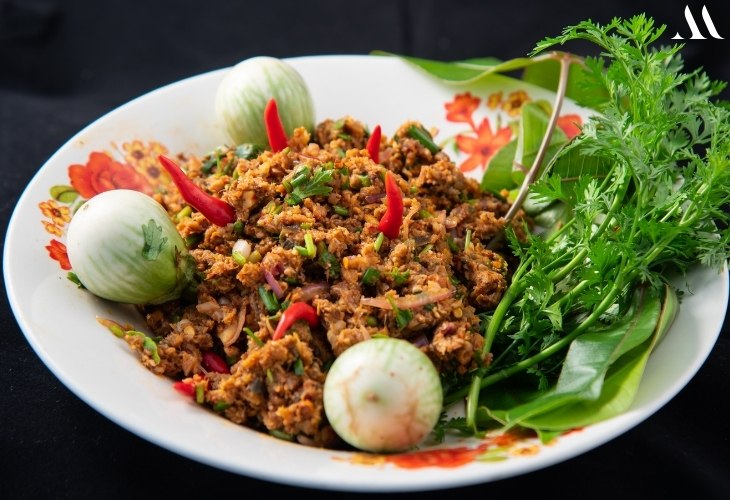
.jpg)
This region offers one a glimpse of old Thailand rice fields, water buffaloes in muddy ponds, silk weavers working the loom in their homes and pedal-rickshaw pullers. The Khao Yai National Park situated in this region spans five different forest types. It is teeming with wildlife and has some exciting hiking trails. For the more historically inclined, Phanom Rung Historical Park and Muang Tam are two Khmer temple complexes that are well worth visiting.
Central Region
This region's food is an amalgamation of all regions' influences but more influenced by both royal-court cuisine and foreign cooking styles, from Chinese to Malay-Muslim. Sweet and rich flavours rule in central Thai dishes. Many great rivers converge in these central flat region, making it a fertile plain for rice growing. Bangkok, the largest city of central Thailand, was the seat of the former Thai kingdoms of Sukhothai and Ayutthaya and the Dvaravati culture of the Mon people before the Tai groups arrived in this area.
.jpg)

Bangkok offers a mind-boggling spread of food, which has a global appeal yet is distinctly Thai. Meals here consist of four to five different courses and include a soup, a fried dish, curry, fish, vegetables and a dessert. Kaeng Phet or the Thai red curry is now a global phenomenon. Central Thai dishes like Tom Yum soup and Kung Pao Chicken are found on menus worldwide. Made with yolk, flour and sugar syrup, Thong Yod or Gold drop and thong yip (pick up gold) are two of the most sought-after deserts here.



Bangkok is known as the world capital of street food. The quality and variety of street food here is world-renowned. Mobile street stalls sell Kap Klaem or ‘drinking food’. Popular Kap Klaem dishes are sun-dried squids, meat on skewers and fried insects or sausages. Sweet roti or fried flat dough filled with bananas or chocolate is another street favourite. Night food markets along busy streets during the evenings are not to be missed. The food in the Thai wet markets is pre-cooked and very popular with the working-class people.
Thailand also has a sizeable Thai-Indian population, and many restaurants cater the Indian vegetarian cuisine.
Southern Thailand
Moving towards the South, the changing landscape matches the changing food scene. Southern Thai cooking is the spiciest of Thailand’s regional cooking styles. It can also be very salty, and not surprisingly, given the south’s coastline, seafood is the star. Wherever you go, prepare to bring back some new ideas about Thai cuisine.

The island of Koh Tao, located in the Gulf of Thailand, is a favourite of divers who come here for the exotic marine life and coral formations. The Chumphon Pinnacle on the island is where most people go to see the famous bull sharks, but the evolutionary sculptures in the Val Tong Tao Bay are also popular with tourists. Ko Pha Ngan's island is most well-known among international tourists for its grand parties held in honour of the full moon. The Khao Sok National Park offers calm and natural beauty. Besides the natural wildlife here, the 185-square-kilometre (71 sq mi) artificial Cheow Lan Lake is a wonderful place to see.
This region may be famous for its beaches, but the food coming from here is certainly just as noteworthy. Thailand is the fourth-largest seafood exporter in the world, and Southern Thailand leads the way. The abundant seafood is reflected in the dishes here. Although Thailand is famous for its curries, the Southern region has spicy and thick curriers made out of coconut milk. Besides coconut, pineapple too flourishes here and finds its way in many signature dishes.

Kua Kling is a southern classic spicy dish made with two primary ingredients – ground meat stir-fried in curry paste. The curry paste is made by grinding the dried chillies and peppercorns and pounding together all the wet ingredients - lemongrass, garlic, turmeric, galangal, salt, shallots, and shrimp paste.
Thailand’s cuisine is intensely regional, and virtually every town is associated with a specific dish that’s unavailable outside the city limits. Listed below are some of Thailand’s more famous regional specialities:

AYUTHAYA – Kuaytiaw ruea (boat noodles)
Rice noodles served with a dark, intense spice-laden broth.
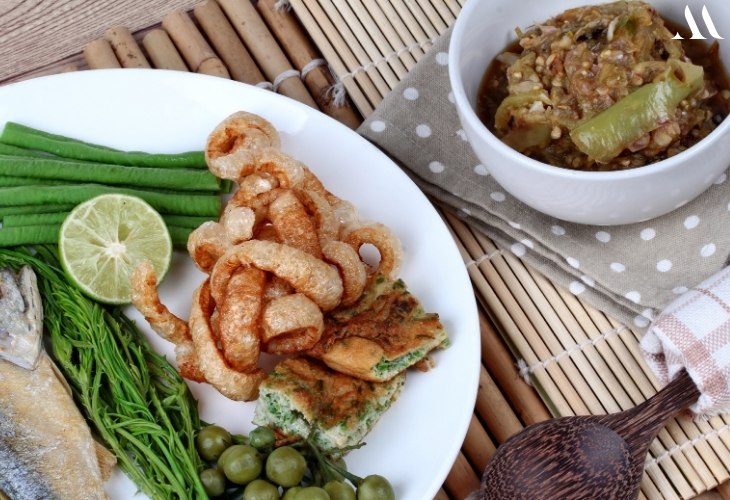
CHIANG MAI – Nam Phrik Num and Khaep Muu (roast chilli ‘dip’ and deep-fried pork crackling)
Available at virtually every market in the city, the two dishes go wonderfully together, ideally accompanied by parboiled vegetables and sticky rice.
HAT YAI – Kai Thawt Hat Yai
The city’s namesake fried chicken is marinated in a dried-spice mixture, which gives it a distinctive red hue.
KHON KAEN – Kai Yang
Marinated free-range chicken grilled over hot coals – a north-eastern speciality that’s said to be best in this town.

LAMPANG – Khao Taen
Deep-fried sticky-rice cakes drizzled with palm sugar are a popular treat in this northern town.
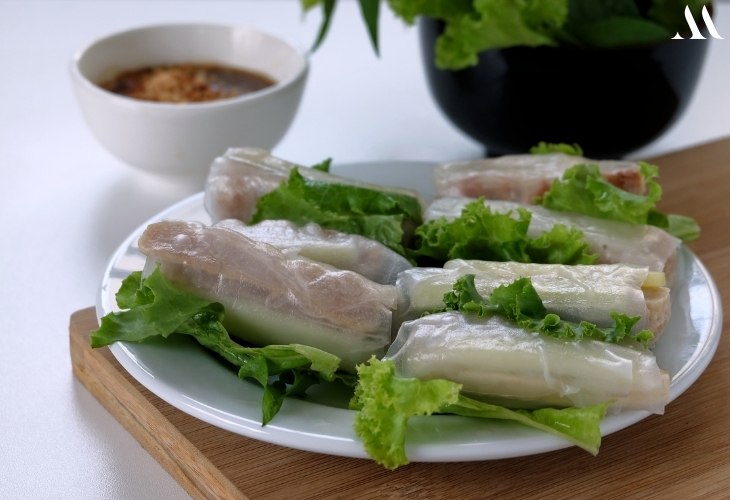
NONG KHAI – Naem Neuang
This Vietnamese dish of pork balls served with rice paper wrappers and a basket of herbs has found a home in northeastern Thailand.

PHETCHABURI – Khao Chae
The best version of this odd but delicious dish of chilled fragrant rice served with sweet and savoury sides hails from this central Thai town.
TRANG – Muu Yang
Roast pig, skin and all, typically eaten as part of a dim-sum brunch, is a speciality of this southern town.
Ten Popular and Traditional Dishes
Tom Yum Goong
Spicy and sour soup usually made with prawns and/or other seafood. Flavoured with lime and chillies, it is a refreshing soup if a little spicy in the full Thai version. Remember that most of the things in there are to add to the flavour, not to be eaten. Tom Yum Goong has become a national dish, liked by most Thais and foreigners.
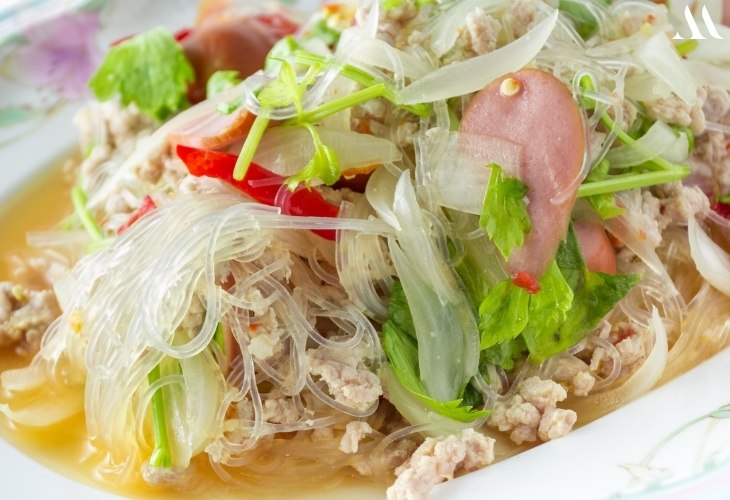
Yum Woon Sen
Clear noodle salad. Like Tom Yum Goong, it is flavoured with lime, fish sauce and chillies speciality, and topped with cooked prawns and lots and lots of fresh herbs. An all-time favourite, but specify how spicy you want it.
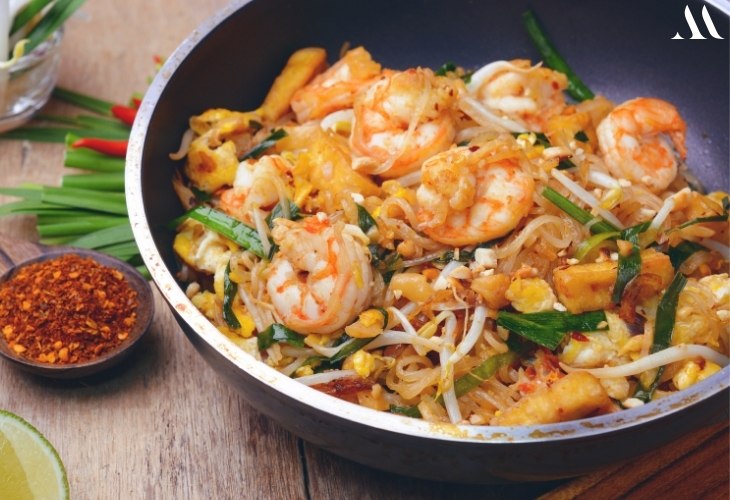
Pad Thai
Fried rice noodles. This is a true Thai concoction, as opposed to most dishes with either Chinese or Indian origins or influences. The sweet, sour and spicy noodles are sprinkled with peanuts, more chillies and more lime—a favourite lunchtime dish.

Pad Bai Krapao
A stir-fry dish of either chicken, beef or seafood with lots and lots of garlic and chillies. This dish is made more intense by the addition of spicy holy basil leaves. It is eaten with plenty of rice (and water!).

Grilled Chicken and Sticky Rice
Originally from the north-eastern region, where sticky rice is consumed instead of normal rice. A whole chicken (or pieces) is marinated in a mixture of herbs and spices and barbecued. This popular dish is usually bought by the roadside and is hardly cooked at home—and may pose the sophisticated restaurant some problem. It can be eaten any time, for breakfast, lunch, dinner or as a snack. Particularly good with Thai whisky/soda or beer.

Som Tum
A spicy salad of fresh, grated green papaya. Also, a northeastern dish usually forms a trio with grilled chicken and sticky rice to make a perfect, balanced meal at any time of the day.

Gaeng Som
A clear, sour curry is a fiery-orange coloured classic staple curry that people from the south enjoy, usually at dinner. An authentic Gaeng Som should have three distinct flavours, leading with sour, followed by salty with only a hint of sweetness. Made from a base of shrimp paste, shallots and chillies, it gets its characteristic sourness from the addition of tamarind.

Nam Prik Kapi
Chilli dip with vegetables. This dish can be as simple or as complicated as the budget or taste buds allow. The pungent dip is made from shrimp paste, chillies, garlic and lime juice. Fresh, steamed, or deep-fried vegetable pieces usually accompany this dip.

Gaeng Keow Wan
Spicy green curry. This is the national favourite dish and is usually eaten with rice noodles.

Kao Kluk Kapi
An old-time favourite amongst Thais but, due to its strong taste, not too popular with foreigners. Cooked rice is fried with shrimp paste, giving it a distinct pungent flavour. What makes this dish truly unique is the variety of its accompaniments: deep-fried, crispy vegetables; thinly fried, rolled omelette; crispy fried small shrimps; sliced shallot; lime wedges; sweet pork cooked in coconut sugar; and, finally, grated green mango.
WHERE TO EAT LOCAL FOOD
The best places to eat in Thailand are often the most unassuming.
One of the best places to find local Thai food is at the local restaurants (food-to-order shop). This type of restaurant can often be recognised by a large display of raw ingredients – Chinese kale, tomatoes, chopped pork, fresh or dried fish, noodles, eggplant, spring onions. As the name implies, the cooks prepare just about any dish you can name, from soups to salads to stir-fries. Such restaurants are found in virtually every Thai town, are usually open-air, with seating being little more than plastic stools at the side of a street, and are largely run by Thais of Chinese origin.
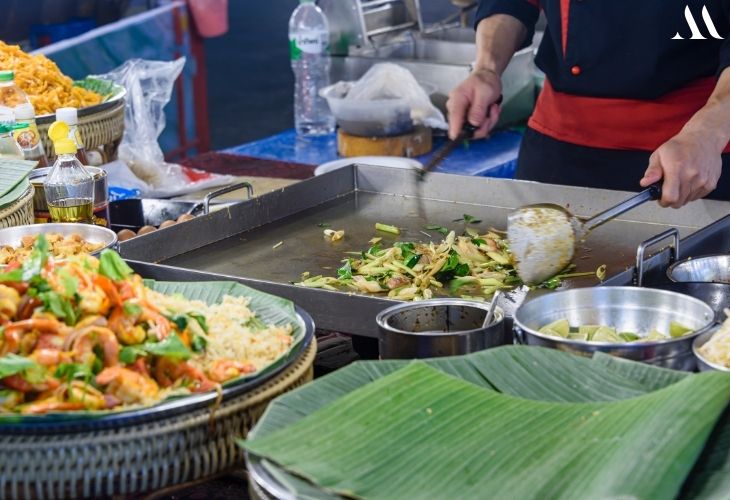

The Delicious Curries of Thailand
Curry in Thailand is called kaeng, and it may be yellow, red, or green, which can be read as “hot,” “hotter,” and “Hottest! Spices for yellow, red, and green curries, from mild to hot.

Yellow curries (kaeng kari) are a good starting point for novices as they are milder in comparison. Like all Thai curries, they have a base of coconut milk with a paste of toasted and powdered spices, which in this case includes turmeric (for the yellow hue), star anise, cinnamon, bay leaves, crushed dried chillies, fermented shrimp paste, ginger, coriander seeds, and cumin. They may be strengthened with beef, lamb, or chicken chunks and usually include onions, potatoes, and pineapple chunks.

Red curries (kaeng phet) have generous amounts of red chilli powder. They are made with white pepper, cumin, coriander seeds, nutmeg, cilantro roots, garlic, lemongrass, the grated rind of fragrant kaffir limes ginger or, preferably, the more potent Southeast Asian root galangal. They also have coconut milk, of course, for a sauce well suited to roasted pork, duck, beef, shrimp, or eel. Bamboo shoots, sweet Thai basil, and pumpkin are sometimes tossed in as well.
Green curries (kaeng keow wan) get their tempting colour and their hotness from plenty of deceptive looking hot green chillies, seeds and all and coriander (seeds, leaves and stems). The spice paste is made by grinding together lemongrass, shallots, ginger, cumin, white pepper, and kaffir lime zest, along with palm sugar, garlic, and holy basil, a strongly flavoured herb that is a particular favourite in Thailand. The paste is cooked in coconut milk and beef or chicken and quartered small, and round Thai eggplants are the standard additions to this hottest of hot curries.
Massaman curry (kaeng musmun) is more Indian in style and is actually a legacy of Muslim spice traders, hence its name, which probably evolved from Arabic. Certainly, it contains plenty of the spice trader’s wares: cumin, caraway, cinnamon, cloves, star anise, cardamom, nutmeg, white pepper, and ginger. It also has cashews, limes, garlic, lemongrass, and tiny, super-hot red bird’s-eye chillies. Although it is spicy, the overall effect is more aromatic than fiery, balanced by the tart juice of tamarind or bitter oranges, as well as chunks of potato, pineapple, and chicken or beef. It is rarely made with pork, likely due to the dish’s Muslim roots. Massaman curry is typically served with sweet-tart pickled ginger or achar, a pickled cucumber relish, and, as with all Thai curries, bowls of steamed white rice—either fluffy, flowery jasmine or the delightfully dense and chewy sticky rice. A great favourite in Thailand and loved across the world for its multicultural influence.
Culinary Tourism in Thailand
Thailand’s bid to attract “quality tourists” has developed new strategies to attract tourists, including culinary tourism.
Through short courses and extended tours, visitors are provided with access to recipes for both royal palace cuisine and rural dishes.
BLUE ELEPHANT COOKING SCHOOL
www.blueelephant.com
Courses from US$90 in Bangkok and Phuket
HELPING HANDS
www.cookingwithpoo.com
Courses from US$40; Bangkok
BAAN THAI COOKERY SCHOOL
www.cookinthai.com
Courses from US$30; Chiang Mai
KHAO COOKING SCHOOL
www.khaocookingschool.com
Courses from US$48; Bangkok
CHIANG MAI THAI COOKERY SCHOOL
www.thaicookeryschool.com
Courses from US$50; Chiang Mai
SAMUI INSTITUTE OF THAI CULINARY ARTS
www.sitca.net
Courses from US$65; Ko Samui
MOM TRI’S BOATHOUSE
www.boathousephuket.com
Courses from US$70; Phuket
Students receive a certificate at the end of the course, recognizing them as Thai chefs. The purpose of such a cooking course was basically to show off Thai culinary skills and allow the students to order a wider range of authentic dishes in Thai restaurants.
Thailand is an excellent destination to experience the rural and luxury, beach and mountains, adventure and culinary delights. A perfect getaway for family or for travelling alone as a woman! It's easy, affordable, very safe, and welcoming.













